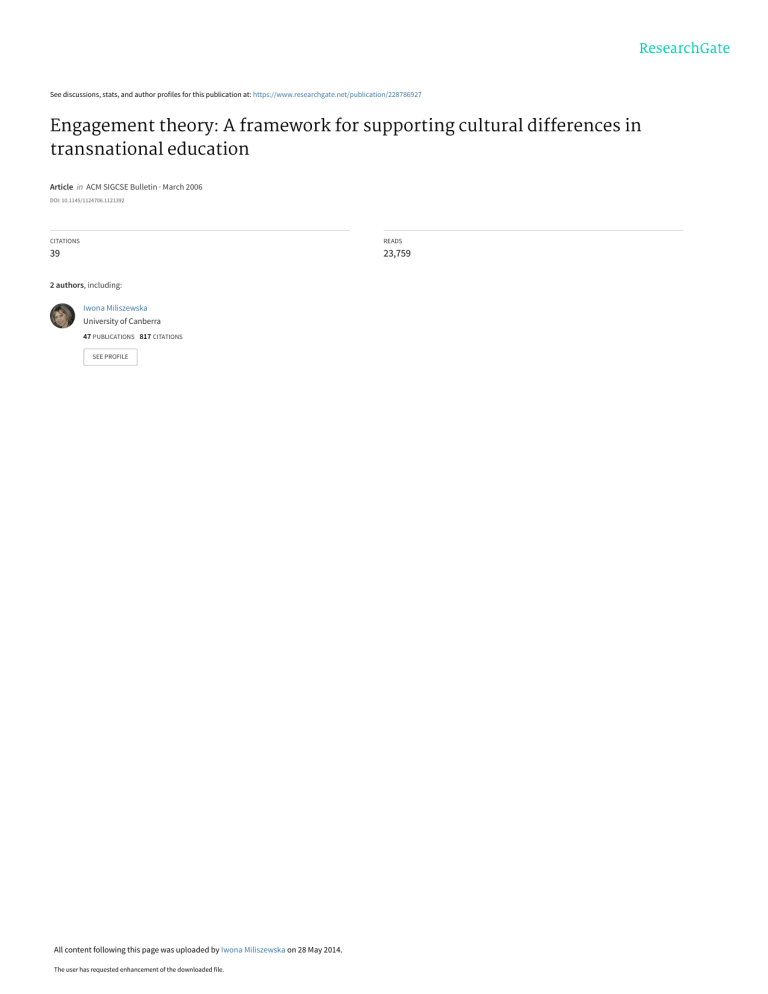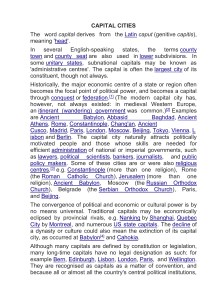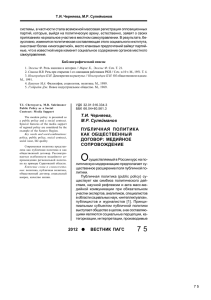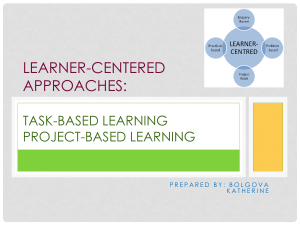
See discussions, stats, and author profiles for this publication at: https://www.researchgate.net/publication/228786927 Engagement theory: A framework for supporting cultural differences in transnational education Article in ACM SIGCSE Bulletin · March 2006 DOI: 10.1145/1124706.1121392 CITATIONS READS 39 23,759 2 authors, including: Iwona Miliszewska University of Canberra 47 PUBLICATIONS 817 CITATIONS SEE PROFILE All content following this page was uploaded by Iwona Miliszewska on 28 May 2014. The user has requested enhancement of the downloaded file. Engagement theory: A framework for supporting cultural differences in transnational education Iwona Miliszewska Victoria University, Melbourne, Australia [email protected] John Horwood Victoria University, Melbourne, Australia [email protected] Abstract: Transnational education typically uses a combination of face-to-face instruction delivered by local teaching staff and teaching materials produced in the offering institution’s home country. Thus, the design of transnational courses needs to be culturally responsive and tailored to the learning styles and social context of students in a foreign locale. To this end, the students’ educational assumptions and expectations, as well as educational practices need to be considered. A Computer Science degree, offered by Victoria University both locally in Australia and transnationally in Hong Kong, includes a compulsory final year Project subject. The Project, a team effort, involves the design and implementation of a real-life computer application for an external client. The Project model, based on Engagement Theory as a conceptual framework for teaching and learning, includes three core components of group context, project-based problems, and outside focus. Although the model used in Hong Kong has been modified to accommodate a variety of time, distance and cultural constraints, its core components remained unchanged. Academics responsible for the degree consider these three Project components essential to transforming computing students into competent graduates. Do Project students, both in Melbourne and in Hong Kong, support this view? This paper reports on a comparative study of the students’ perceptions of the Project experience and the relative importance of its three components. The paper discusses the results of the study with respect to the different locales, and concludes by considering the implications of the study for the Project model. Keywords: Transnational education; engagement theory; cultural constraints. Introduction Transnational education refers to the delivery of distance education to students in a country different from that of the offering institution. Financial imperatives undoubtedly underpin the decision by universities to become involved in transnational education. However, their survival in a global educational environment is dependent on the quality of their “educational product” i.e. the quality of the design and delivery of the transnational programs. Herein lies the dilemma: can programs designed and developed for one cultural milieu be successful in a different cultural milieu? Victoria University offers a transnational computer science degree in Hong Kong. The challenge is to provide a credentialed qualification that also offers students a meaningful learning environment. This challenge is compounded by the fact that the degree is required to be identical to that offered by the university in Australia, while at the same time meeting the expectations of students in both locales. The degree program involves a Project subject, which utilizes the knowledge gained throughout the program to develop a real-life computer system. The Project is designed to consolidate existing knowledge, and to empower students through engagement with a genuine work environment; it is an integral part of the computer science degree. Most subjects of the transnational degree are taught with the aid of part-time local teaching staff (Hong Kong lecturers); however the Project, regarded as critical to the quality of the degree, is conducted by Melbourne lecturers in distance education mode. The Project is modeled on the conceptual framework of engagement theory and represents a particular approach to teaching and learning, which is considered most effective by Melbourne lecturers. It was important to discover if students, both in Australia and in Hong Kong, shared that view, and the extent to which engagement theory provides a framework for supporting cultural differences. As opinions on the matter of adaptability of transnational programs are divided – some argue that those programs should be tailored to the specific cultural context of the students (Kelly & Tak, 1998); others claim that cultural differences can be overcome by applying universal principles of good teaching regardless of where the program is taught (Biggs, 1997) – it was important to also investigate if students’ perceptions of the Project were locale dependent. Engagement theory The aim of the Project subject is to provide students with an opportunity to work on a real-life software development project; to appreciate the needs of the business client for whom they are expected to build the software system; to apply software engineering and database design methodologies to the design and implementation of a complete system; to confront issues developers face on a daily basis, such as liaison with clients, working in a team, documenting the project; to gain experience in translating their knowledge into practice; and to obtain feedback concerning their progress from intensive reviews of their work. The Project promotes Problem Based Learning (PBL). Many variations of PBL have been documented, but all of them include situations where an initial problem serves as a catalyst for subsequent learning (Fogarty, 1997; Kingsland, 1996). The learning that occurs in working with the problem enables students to develop new knowledge, as well as further consolidate their existing skills and knowledge (Schiller, Ostwald & Chen, 1994). Students have a greater responsibility for their own learning and receive less guidance from the teacher, factors distinguishing PBL from subject-based learning (Dolmans, 1992). The role of the teacher is different too: it is one of consultant rather than instructor. PBL usually includes a collaborative component; students often work in groups where collective decisions are made about task distribution, and where group members investigate different aspects of the problem that together contribute to the total solution. The Project advocates PBL, a collaborative environment, and the pursuit of worthwhile projects, that is, real projects commissioned by real clients. The emphasis on “authentic” tasks, PBL, and collaboration exemplify the three components of a conceptual framework for learning – Engagement Theory. The major premise of engagement theory is that students must be engaged in their course work in order for effective learning to occur. The theory posits three primary means to accomplish engagement: (1) an emphasis on collaborative efforts, (2) project-based assignments, and (3) non-academic focus. It is suggested that these three methods result in learning that is creative, meaningful, and authentic (Kearsley & Schneiderman, 1999). Engagement theory is based on the idea of creating successful collaborative teams that work on tasks that are meaningful to someone outside the classroom. Its core principles are summarized as “Relate”, which emphasizes characteristics such as communication and social skills that are involved in team effort; “Create”, which regards learning as a creative, purposeful activity; and “Donate”, which encourages learners to position their learning in terms of wider community involvement. To this end, the Project presents itself as a perfect example of a real-life application of engagement theory. Project model The Project was included as a mandatory subject in the computer science degree to enable students to consolidate the knowledge and skills gained throughout the degree. As a consequence, an elaborate system of project supervision exists to support Melbourne students. Students are divided into groups; each group is allocated an industry project and an academic supervisor. The project is sourced, by the Project coordinator, from local business and industry, and typically is an application of interest to the client. The groups meet with their academic supervisor on a regular basis and review progress, but major responsibility for project completion rests with the students. Assessment is based on project reports and two presentations – one mid-term and one at the conclusion of the project. The Project has proved a very successful vehicle in bridging the transition from the theoretical or restricted knowledge of the classroom to the broader environment of the workplace (Churcher & Cockburn, 1997). It has also proved very appealing to prospective employers. The Hong Kong Project model varies from the one provided in Melbourne, but the differences are still within limits of transnational education: University regulations require that a transnational offering of a course be the same in all locales, only making necessary allowances for differences arising from the educational context. The barrier of distance excluded replication of the Melbourne model and, as a result, a hybrid solution incorporating both distance and traditional educational methods was adopted (Dede, 1996). This solution made use of the Internet and electronic communication, but not to the exclusion of the faceto-face contact. The biggest difference relates to the sourcing of potential projects in Hong Kong – it is the responsibility of the students, and not the Melbourne based Project coordinator. Students organize themselves into groups, and each group finds a project supported by a sponsor (client) from the local industry. The Project is divided into three stages; individual project groups submit reports and meet with the project coordinator at each stage. The face-to-face meetings with individual groups facilitate resolution of problems that could not be addressed adequately in a general manner, or solely in written mode (Bullock, 1998). During the final meeting students demonstrate their systems. Grades are awarded on project reports and software demonstration, while feedback on progress is provided throughout. The Internet is used for submission of project documentation. A system, using Java, Web browsers and JavaScript was developed to facilitate these submissions. Its major components comprise a Web browser user interface and a client-server application written in Java. In addition, Project Web site, Project Discussion Room, and electronic mail are used extensively for individual, group, and global communication. Access to the University library is also provided through the Internet, as is an index cataloguing public domain and free software, Standards groups Web sites, and research material. A quality mechanism ensuring the academic validity of the Project and its equivalence in both locales has two perspectives: institutional and educational. As an institution, the University has developed regulations and guidelines to which any program, including transnational, must adhere, and the Project is no exception. The Academic Board is particularly concerned with academic matters, including teaching arrangements, resources and assessment. Educationally, academics responsible for the Project must guarantee its quality. To this end, the Project model reflects the universal seven principles for good practice in undergraduate education (Chickering & Ehrmann, 1996; Chickering & Gamson, 1987). Project as engagement Regardless of location, the Project is always structured around the key components of engagement theory – Relate, Create and Donate. Students are divided into groups (relate); and each group is responsible for an industry project (create) that is important to a local business (donate). Relate To best imitate the real-life software development environment, students work in groups of four. This not only exposes them to teamwork but also to projects that are more substantial. Students are expected to form their own project groups, although the group composition is monitored by the project coordinator. This results in few reports of interaction problems and gives students a chance to effectively pool their expertise. A project is usually of better quality if the project group is composed of a database “expert”, a Graphical User Interface developer, a CASE tool practitioner and a person experienced in software documentation. This differentiation of tasks is better negotiated within compatible groups. All students contribute to each stage of the project and thus gain experience in all aspects of software development, in the process developing interpersonal relationships and collaborative skills. Create The project typically involves a problem situated in the “real-world”, and requires the development of a computer system. Students engage in the creative process by analyzing the problem, developing a system design, and implementing it. However, the pressure on the students for successful completion in a restricted timeframe is minimized. Thus, students are able to concentrate on the problem in hand. They can proceed at a pace that enables them to gain maximum benefit from the experience, and complete work that is of high standard. Donate While working on projects, students interact with real-world clients and solve real-world “big” problems. The advantage of this approach is threefold. Firstly, the students gain an experience of computing “in the large”. Secondly, they interact with their clients in a similar manner to software developers. Thirdly, the students see their software systems deployed in actual organizations thereby gaining a sense of satisfaction and confidence in their skills. Questions and concerns The Project represents and promotes the philosophy of Engagement Theory, and academics consider it an essential ingredient of the computer science course. Although well intended, this approach is based on one important assumption, namely that the students, too, regard it a valuable learning experience. Moreover, the assumption makes no distinction between students from different learning environments, in this instance Melbourne and Hong Kong. The approach raised a number of concerns. With respect to Hong Kong students, one concern was that students, used to teacher-centred education, might not accept the idea of self-directed project work. Research suggests that students faced with this type of work may feel doubtful about its value (Felder & Brent, 1996). However, research also indicates that students usually have greater motivation to learn in the context of solving a problem than if the content is delivered out of context (Idrus, 1993; Schiller et al., 1994). A further concern related to the characterization of Chinese education as “firmly based on knowledge transmission with a single curriculum (often a single textbook). Making the curriculum relevant to everyday life has low priority” (Robinson, 1998), so the Project’s emphasis on real-life context might not seem important. However, there was also evidence to suggest that many of the characteristics of the Chinese learner described above may depend on teaching practices, and that Chinese students could adapt quite easily to student-centered approaches if they were in learning environments that encourage them to do so (Kember, 1998; Kember & Gow, 1991). The cultural divide has presented other, more obvious, implications. Although the degree is offered in Hong Kong, the credential is issued by Victoria University. The language of instruction is English as it is expected in the international marketplace that graduates with a degree from an Australian university should have adequate linguistic competency in English. However, the first language of the majority of students is Cantonese. The graduates from this degree are Hong Kong residents, and most of them will continue to work in Hong Kong. Another issue related to cultural factors was the sourcing of potential projects in Hong Kong. The Project coordinator was not resident in Hong Kong, had no intimate knowledge of the business and industrial environment, and did not possess the language skills to negotiate with prospective clients. For the Melbourne students, the concerns were related more to their work ethic. The secondary curriculum in Australia places great emphasis on student-centered learning and assessment activities, such as research projects and assignments that are located outside the classroom, so the approach of the Project was familiar to the students. However, the concerns revolved around the fear that the easy access of the project groups to an academic supervisor would encourage students to rely more on the university environment for help rather than increasing their collaboration with the external client and the workplace. A further concern was the tendency of supervisors to identify with the success of the project group, and thus to take far too much responsibility for the completion of the project. Given the discrepancies between the nature of the Project and the acknowledged constraints on the students, it is understandable that questions arose regarding the students’ acceptance of the Project. Evaluation A survey was conducted to seek the views of both Melbourne and Hong Kong students on the importance of the characteristics of the Project model, and the relative importance of its three components: group context, project-based task, and outside focus. The students, enrolled in the Project subject in both locales, were surveyed after its completion. All the students were asked to complete a questionnaire; participation in the survey was voluntary. In Hong Kong, 143 of the 160 enrolled students completed the survey. In Melbourne, 72 of the 102 enrolled students completed it. The students’ perceptions of the impact of the individual aspects of the Project on their learning experience are shown in Table 1. A 5-point Likert scale was used, where 5 indicated strongly agree and 1 indicated strongly disagree. The results are reported as percentages on the Likert scale. Table 1: Students’ perceptions of the learning experience Group Context Location 5 4 3 2 Improved my communication, planning, and management skills. Hong Kong Melbourne 44% 43% 53% 47% 3% 9% 1% Forced me to clarify and describe problems, thereby facilitating solutions. Hong Kong Melbourne 42% 35% 52% 55% 6% 9% 1% Helped me understand and accept the perspectives of fellow group members. Hong Kong Melbourne 41% 42% 53% 48% 6% 9% 1% Project-based Task Location 5 4 3 2 Made me apply my knowledge and ideas to a specific task. Hong Kong Melbourne 43% 47% 54% 47% 3% 3% 3% Was more interesting than working on tutorial exercises. Hong Kong Melbourne 41% 39% 55% 44% 4% 14% 3% Gave me a sense of control of my learning. Hong Kong Melbourne 44% 31% 50% 54% 6% 12% 3% Outside Focus Location 5 4 3 2 Increased my motivation for work. Hong Kong Melbourne 26% 31% 62% 48% 11% 18% 1% 3% Taught me skills associated with client interaction and customer service. Hong Kong Melbourne 30% 32% 64% 50% 6% 14% 4% Was more satisfying than working on a textbook problem. Hong Kong Melbourne 30% 44% 64% 44% 6% 11% 1% 1 1 1 Students’ evaluation of the three aspects of the Project in terms of importance to their learning experience is reported as percentages in Table 2. The percentages indicate the proportion of students who regarded that aspect as most important of the three. Table 2: Importance to learning experience Aspect Hong Kong Melbourne Group Context 34% 44% Project-based Task 46% 50% Outside Focus 20% 6% Discussion Results of the survey indicated that the Project was an important learning experience to all students. Both group context and project-based task were regarded as equally important in terms of their contribution to the learning experience although, on average, Hong Kong students rated the importance higher than Melbourne students. Hong Kong students singled out focus on communication planning and management skills, opportunity to apply knowledge and ideas to a specific task, as well as opportunity to control one’s learning as most important characteristics. On the other hand, Melbourne students clearly selected “opportunity to apply knowledge and ideas to a specific task” as the most important characteristic of the project-based task, valuing it even higher than their Hong Kong counterparts. However, they differed considerably, from the Hong Kong students, in their assessment of “control of one’s learning” attributed to project-based task; only 31% of Melbourne students agreed strongly, as opposed to 44% of those in Hong Kong. Although the outside focus was acknowledged as providing benefits, both groups of students rated these benefits not as highly as those associated with project-based task and group context. While the relative ranking of the individual aspects of the Project model revealed that the group context was highly regarded, the project-based task was clearly valued highest, and outside focus ranked significantly lower than the other aspects (Table 2). The highest ranking of the project-based task confirmed that the initial concerns regarding Hong Kong students’ lack of appreciation for self-directed project work were unfounded. Likewise, the perception that Hong Kong students might not find the real-life context important because, traditionally, Chinese education gives low priority to links between curriculum and everyday life, has been dispelled. While the Hong Kong students, indeed, rated the outside focus as least important to their learning experience, Melbourne students almost rejected that aspect altogether – and they had not experienced the Chinese education system. This pronounced lack of appreciation for the outside focus is rather puzzling as students, wishing to secure employment upon graduation, should be aware that employers place high value on graduates with prior real-life computing experience. How can this phenomenon be explained? There might be several explanations: Hong Kong students are all in full-time employment, and already work in a real-world environment; for Hong Kong students, the difficulties associated with securing an external project, communicating with clients, and meeting additional requirements may outweigh, in their opinion, the benefits of a “bigcomputing” experience; Melbourne students, usually school leavers studying full-time, may lack maturity needed to think seriously about their future careers; or, maybe, having the “luxury” of frequent meetings and continuous support of their academic project supervisor, the Melbourne students do not see that much difference between working on a real-life and any other assignment. Conclusions The aim of this research was to compare the perceptions of Project students in various learning environments – Melbourne and Hong Kong – and to investigate the appropriateness of engagement theory as a paradigm to underpin a culturally inclusive curriculum in a transnational context. The Project was always perceived by academics as important to the successful culmination of the computer science degree, and the responses of both the Hong Kong and the Melbourne students tend to support this view. The contribution to the learning process of group context and project-based task was highly valued by students, independent of locale, whereas the role of outside focus was more problematic. Clearly some students valued the subject in terms of content, in the form of “project-based task”, whereas a significant number also appreciated the sense of collaboration engendered by the “group context”. However, only a minority believed that the “outside focus” provided a significant contribution to their learning experience, and most of these students were from Hong Kong and already in employment. The difference between the Hong Kong and Melbourne students could be explained in terms of their employment background – Hong Kong students already had work experience, whereas Melbourne students had none, coming to the course directly from secondary school. Of more significance to this discussion was the reluctance of students from either locale to acknowledge the primary importance of the “outside focus” to their learning experience. This research would suggest that the “create” and “relate” components of engagement theory were valued and embraced willingly by students, independent of cultural context, whereas the “donate” aspect appeared to be outside their realm of experience. Having had little exposure to any learning practice that was located in the “real-world”, students seemed unable to respond to, and achieve benefits from, a real-world learning context. Questions remain regarding the importance of the “outside focus”. From the perspective of the Project, there is no doubt that academics regard “outside focus” of paramount importance. The issue is that students fail to share this conviction, and ways to remedy this situation need investigation. However, this research indicates that engagement theory might provide a framework for structuring a culturally inclusive curriculum, especially if the curriculum includes a substantial PBL component. References Biggs, J.B. (1997). Teaching across and within cultures: the issue of international students. In Murray-Harvey, R. & Silins, H.C. (Eds.) Learning and Teaching in Higher Education: Advancing International Perspectives, Proceedings of the Higher Education Research and Development Society of Australasia Conference (Adelaide), HERDSA, 1-22. Bullock, J.F. (1998). Internet technologies for enterprise development and learning. ALN Magazine, 2(1). Retrieved December, 2002, from http://www.aln.org/alnweb/magazine/vol2_issue1/bullock.htm Chickering, A.W., & Ehrmann, S.C. (1996). Implementing the seven principles: technology as lever. AAHE Bulletin, 49(2). Chickering, A., & Gamson, Z. (1997). Seven Principles of Good Practice in Undergraduate Education. AAHE Bulletin, 39(7), 3-7. Churcher, N., & Cockburn, A. (1997). An immersion model for software engineering projects. Proceedings of the Second Australasian Conference on Computer Science Education, (Melbourne). Dede, C. (1996). Distance learning to distributed learning: making the transition. Learning & Leading with Technology, 23(7). Retrieved December, 2002, from http://www.educause.edu/nlii/articles/dede.html Dolmans, D. (1992). The relationship between student-generated learning issues and self-study in problem-based learning. Instructional Science, 22(4), 251-267. Felder, R., & Brent, R. (1996). Navigating the bumpy road to student-centred instruction. College Teaching, 44(2), 43-47. Fogarty, R. (1997). Problem-Based Learning and Other Curriculum Models for the Multiple Intelligences Classroom. ERIC Document No. ED405143. Idrus, R. (1993). Collaborative learning through teletutorials. British Journal of Educational Technology, 24(3), 179-184. Kearsley, G., & Shneiderman, B. (1999). Engagement Theory: A framework for technology-based teaching and learning. Retrieved July, 2003, from http://home.sprynet.com/~gkearsley/engage.htm Kelly, M.E., & Tak, S.H. (1998). Borderless education and teaching and learning cultures: the case of Hong Kong. Australian Universities’ Review, 41(1), 26-33. Kember, D. (1998). The Learning Experience of Asian Students: A Challenge to Widely-held Beliefs. Plenary Address given at the 12th Annual Conference of the Asian Association of Open Universities, (Hong Kong). Kember, R., & Gow, L. (1991). A challenge to the anecdotal stereotype of the Asian student. Studies in Higher Education, 16(2), 117-128. Kingsland, A. (1996). Time expenditure, workload, and student satisfaction in problem-based learning. In Wilkerson, L. & Gijselaers, W.H. (Eds.) Bringing Problem-Based Learning to Higher Education: Theory and Practice. (pp.73-81). San Francisco: Jossey-bass Publishers. Robinson, B. (1998). Asian learners, Western models: Some discontinuities and issues for distance learners. Proceedings of the 12th Annual Conference of the Asian Association of Open Universities. Part III, (Hong Kong), The Open University of Hong Kong, 370-375. Schiller, J., Ostwald, M., & Chen, S. (1994). Implementing a problem-based, distance education undergraduate course in construction management. Distance Education, 15(2), 300-317 Copyright © 2004 Iwona Miliszewska & John Horwood: The authors assign to HERDSA and educational non-profit institutions a non-exclusive licence to use this document for personal use and in courses of instruction provided that the article is used in full and this copyright statement is reproduced. The authors also grant a non-exclusive licence to HERDSA to publish this document in full on the World Wide Web (prime sites and mirrors) on CD-ROM and in printed form within the HERDSA 2004 conference proceedings. Any other usage is prohibited without the express permission of the authors. View publication stats







